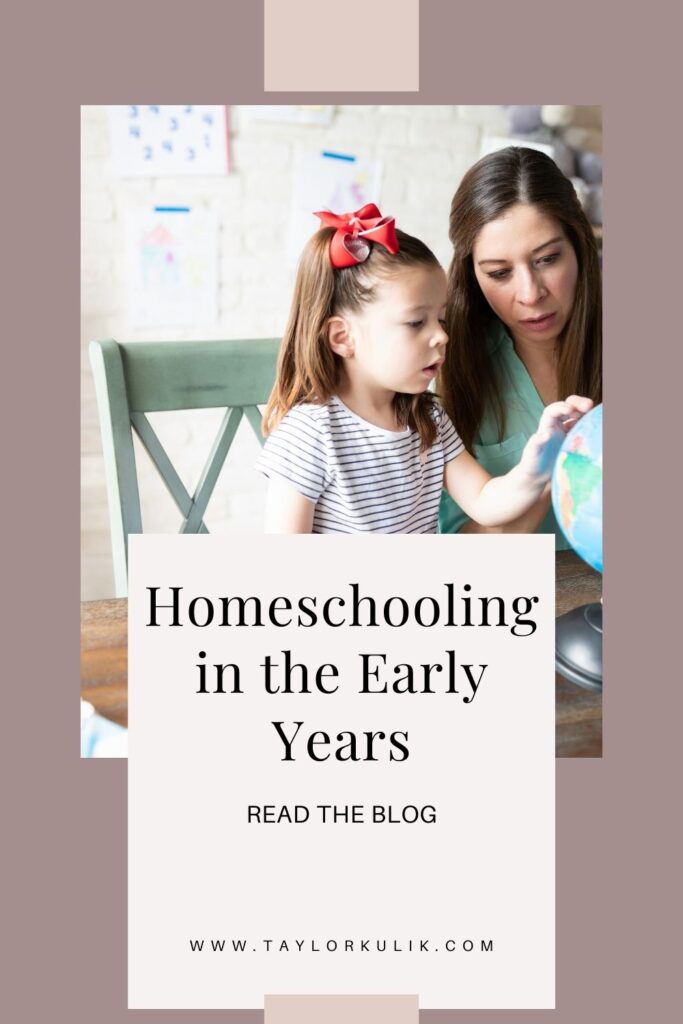“The best education does not happen at a desk, but rather engaged in everyday living – hands-on, exploring, in active relationship with life.”
Vince Gowman
We are just beginning our school year (we plan on schooling year round), and I want to share our curriculum picks for this year (first grade), and what we’ve used in the past. I always feel a bit like an imposter when I share about homeschool because we are so new to it, and I am by no means an expert or experienced, but I think find it helpful to hear the experiences of lots of different homeschooling families, even those that are less experienced.

Finding an aligned homeschool approach
The first thing that I think any parent who is interested in homeschooling should do is explore a variety of different homeschool styles and approaches. There are so many ways to homeschool, and it seems that many families find different approaches work better for different children. I know many families also mix approaches/styles. What’s helpful is to get an idea of the different homeschool philosophies out there and find one that feels aligned with your values and priorities. Don’t worry though- you can always switch up how you approach homeschooling if something isn’t working for you. You aren’t set in one particular philosophy or approach forever.
If you know any homeschooling families, I highly encourage you to chat with them and get to know their philosophies and why they chose to homeschool like they do. I found it helpful to ask different families about what a typical homeschool day looks like for them; I found turned off by some approaches based on the typical schedule and routines, while I was drawn towards other approaches when I heard a family’s daily routines and rhythms.
There are also many helpful online resources and books that can help you learn more about different homeschool philosophies. (You can find some of my favorite homeschool books and resources here.)
The Charlotte Mason Approach + Curriculum
We currently choose to homeschool based on Charlotte Mason’s educational philosophy as that is the approach that has always resonated the most with my values and priorities for my children. Just a note here (this was something that confused me when I first started researching), that Charlotte Mason is an educational philosophy, but not a specific curriculum. There are many curriculums that are created using the Charlotte Mason philosophy and principles.
E is 6, and is starting first grade this year (also called Year 1). Charlotte Mason believed that formal schooling should not start until the age of 6 or 7, and that the years prior to this should just be spent playing in nature and forming habits and rhythms. Last year, we did veer from this approach just a bit because we completed a very light kindergarten curriculum that was still based on CM philosophy. It wasn’t necessary, but I wanted to ease into schooling and help us establish school rhythms and routines before year 1, plus E was asking to “do school”, and she loves to learn. We used the kindergarten curriculum from A Humble Place. It took about 1-1.5 hours, 4 days per week to complete. I felt it was a great intro to CM homeschool. The beautiful thing about this curriculum is that it consists mostly of reading living books and stories, and you can add on some math or reading if you’d like, but it’s not necessary.
I think it’s so important to understand that the foundation of formal learning is gained in the early years through play, exploration, observing nature and the world, and reading enjoyable stories. So many parents think they must start doing formal education and worksheets with their preschool-aged children to prepare them for school, but this is not true. There is an abundance of research and data to demonstrate that when children start formal school later, their educational outcomes tend to be better.
Nature Study + Preschool/Kindergarten Curriculum Choices
Nature study is an important part of Charlotte Mason philosophy, and nature study alone is all you need for for preschoolers and kindergarten. You truly do not need a curriculum at all in the younger years, but I’ve found it helpful to have a bit of structure and guidance for myself.
We have tried a couple of different nature curriculums in the past. For the early years, we used Blossom & Root early years nature curriculum, and we enjoyed it. We’ve also used Raising Little Shoots’ Exploring Nature with Children. Honestly, both of these curriculums are great, but I found I needed something a bit more substantial since I have never really done nature study, myself. I think it really depends on your skillset and where you are starting as a parent. Both of these curriculums are great options for the early years, and parents can have a lot of success with them, but personally, I had a hard time being consistent with them.
I finally found a nature curriculum that I absolutely love and provides me with enough substance to guide me along the way- my very favorite is Treehouse Schoolhouse’s nature curriculum. Nature study is a concept that is very new to me, and I really need someone to hold my hand through it, and that’s exactly what this curriculum provides. It’s an open and go full nature curriculum, and you can adapt it to your own preferences and needs. There is plenty you can do each week if you want to do nature study each day, but you can also pick and choose what you want to do if you only want to do nature study 1 or 2 times per week. I love that I have options! Sometimes, we spread it out and spend two weeks completing one week of nature study to really go deeper on a subject. This is an incredible stand alone curriculum for the early years if you are looking for something like that! You can save 10% on Treehouse Schoolhouse resources with the code TAYLORKULIK.
First Grade Curriculum Choices
This year will be our first year using Ambleside curriculum. Ambleside is a CM based curriculum, and the best news is that the curriculum itself is totally free. Ambleside has extensive online resources to support parents. Ambleside curriculum includes many rich living books (an important part of the CM philosophy), so this is the bulk of the cost, but you can find many of these books for free online, at the library, or get inexpensive copies from a used book store.
Ambleside curriculum does not include math or reading, so you have to add in your own choice of curriculum for those subjects. This year, we are trying Life of Fred for our math curriculum (I’ve linked the entire elementary set of books). Last year, we used MEP, a free math curriculum.
We began working on reading last year at E’s request, and we used Teach Your Child To Read in 100 Easy Lessons. I actually love this curriculum. It is very intuitive and makes so much sense for teaching a child to read. I was surprised that within three months of doing a half lesson a day or so, E was reading full sentences. Once E got through the first 60 lessons, she became bored by the long stories, so we began working our way through the Bob books as well as other early readers. I can’t recommend Bob books enough for early readers. They are simple and have fun illustrations, which make them super engaging for kids learning to read. This has worked well for us so far, and we will continue working our way through these books this year. Ambleside curriculum has lots of resources for ongoing reading practice as well.
I hope that was helpful! There’s no one right curriculum or way to homeschool. I’m just sharing what we are doing in the hopes that it will help someone else.
Wishing you a joyful and peaceful homeschool year!



This was very helpful!!
I’m so glad!
Thank you so much for sharing! This post was super helpful! My kids are still young, but homeschooling is always back of mind as I want to slowly introduce it and not just jump in head first when it’s time to really get started. I would love to hear about how you navigate homeschool alongside your business and manage to do both as I am looking to do the same.
I’ll try to share more about that in a blog post or via email soon. I think this is so different for everyone, and you just have to find what works for you with the amount of time you have to put into your business. I have help- childcare 2 afternoons a week, and I get a lot done in the evenings or early mornings, too. But it’s not always easy, and sometimes, I definitely have to drop the ball on the business a little bit when life gets “lifey”.